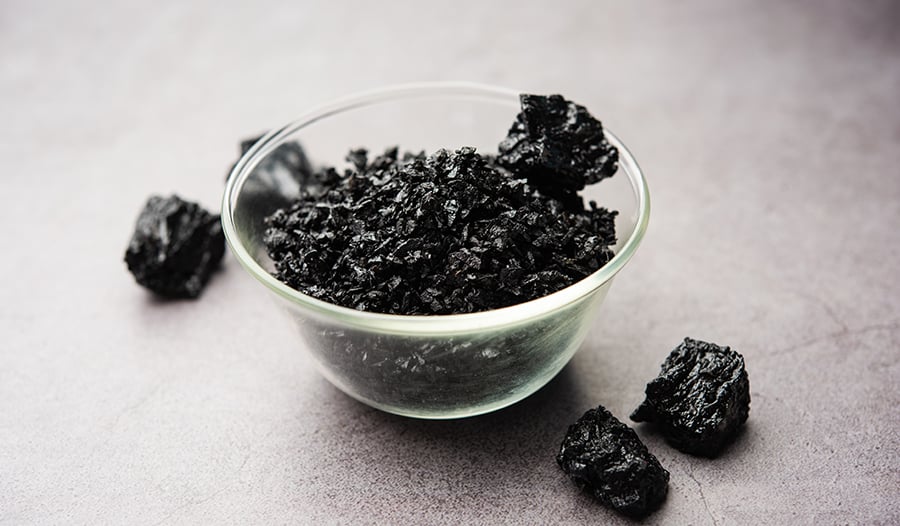Product Description

What is Shilajit? The Ultimate Guide to Himalayan Mineral Resin
🔬 Scientific Definition & Characteristics
Shilajit (Sanskrit: शिलाजीत, “Conqueror of Mountains”) is a biogenic mineral resin formed through centuries-long decomposition of medicinal plants like Euphorbia royleana and Trifolium repens in high-altitude rock crevices. This adaptogenic substance exhibits:
- Texture: Viscous resin (summer) → Brittle solid (winter)
- Color Spectrum: Blackish-brown (common) to amber (rare)
- Odor: Distinctive earthy aroma with pine notes
- Density: 1.1-1.8 g/cm³ (varies by mineral content)
🌍 Global Sources & Geological Formation
| Region | Altitude Range | Key Minerals | Harvest Season |
|---|---|---|---|
| Himalayas (India/Nepal) | 3,000-5,000m | Fulvic acid (60-80 mg/g) | May-July |
| Altai Mountains | 2,500-4,000m | Iron (12-15%) | June-August |
| Caucasus | 1,500-3,500m | Zinc (8-10 ppm) | July-September |
* Geological process: Plant matter compression under 700-1100 MPa pressure over 300-500 years
(Khumalo et al., 2022)
⚗️ Key Bioactive Components
Fulvic Acid Complex (25-35%)
- ✔️ Enhances nutrient absorption by 40-60%
- ✔️ Natural electrolyte balancer
Dibenzo-α-Pyrones (8-12%)
- ✔️ Stimulates ATP production
- ✔️ Mitochondrial support
Trace Minerals (60+ elements)
- ⦿ Iron: 15-18 mg/g
- ⦿ Zinc: 8-12 μg/g
- ⦿ Selenium: 0.2-0.5 ppm
🏅 Quality Certifications to Verify


Specification
| Item | Specification |
|---|---|
| Product Name | Shilajit Extract Powder |
| Botanical Source | Shilajit |
| Part Used | Asphaltum |
| Appearance | Brown powder |
| Active Ingredients | Rich in minerals, fulvic acid, and humic acid |
| Fulvic Acid Content | ≥ 10% (adjustable upon request) |
| Odor | Distinct earthy odor |
| Solubility | Partially soluble in water |
| pH Value | 6.0 - 7.5 |
| Moisture Content | ≤ 5% |
| Heavy Metals | ≤ 10 ppm |
| Arsenic (As) | ≤ 2 ppm |
| Lead (Pb) | ≤ 3 ppm |
| Total Plate Count | < 10,000 CFU/g |
| Yeast and Mold | < 100 CFU/g |
| E. Coli | Not detected |
| Salmonella | Not detected |
| Application | Suitable for dietary supplements, traditional medicine, antioxidant products, etc. |
| Packaging | 1 kg/bag, 5 kg/drum, or customized packaging |
| Storage Condition | Store in a cool, dry place, away from light |
| Shelf Life | 24 months (unopened packaging) |
Function
- ●
Shilajit extract fulvic acid with the function of regulates and controls blood sugar levels and shows hypoglycemic action.
- ●
Shilajit extract fulvic acid with the function of increases the permeability of cell membranes.
- ●
Shilajit extract fulvic acid with the function of accelerates processes of protein and nucleic acid metabolism.
- ●
Shilajit extract fulvic acid with the function as free radical scavenger and reverse damage done by toxic substances.
- ●
Shilajit extract fulvic acid with the function to transport nutrients deep into tissue.
- ●
Shilajit extract fulvic acid with the function restores electrochemical balance and supports immune system.
- ●
Shilajit extract fulvic acid with the function to promote movement of minerals, especially calcium, phosphoru and magnesium into muscle tissue and bones.
faq
Frequently Asked Questions About Sodium Hyaluronate Powder
What is the molecular weight range of your sodium hyaluronate powder?
Our pharmaceutical-grade sodium hyaluronate powder is available in multiple molecular weights:
10-50 kDa (low molecular weight for enhanced skin penetration),
500-800 kDa (standard molecular weight for joint health supplements), and
1.0-1.8 MDa (high molecular weight for viscoelastic applications). Custom molecular weight specifications can be accommodated with MOQ 50kg.
Does your sodium hyaluronate powder meet EU Novel Food regulations?
Yes, our production facility holds FSSC 22000 certification and all documentation complies with EU Regulation (EC) No 258/97.
We provide full technical dossier support including heavy metal analysis (Pb <0.5ppm, As <0.1ppm), microbial limits (TPC <100 CFU/g),
and allergen declaration for food supplement applications.
What’s the recommended dosage for anti-aging skincare formulations?
For topical cosmetic products:
– Serums: 0.5-1.0% w/w
– Creams: 0.2-0.5% w/w
– Patches/masks: 1.0-2.0% w/w
Our R&D team provides free formulation compatibility testing with common ingredients like vitamin C derivatives and retinol.
Can you provide TGA-certified HA powder for Australian medical devices?
We’re ISO 13485:2016 certified for medical-grade sodium hyaluronate production. Our GMP-manufactured batches include:
– Sterility testing (USP <71>)
– Endotoxin levels <0.05 EU/mg
– Full material traceability from fermentation source
Lead time for TGA documentation: 5-7 working days post-shipment.
What’s the difference between microbial fermentation and animal-derived HA?
Our plant-based production uses Streptococcus zooepidemicus fermentation (non-GMO), offering:
– 99.9% animal-free certification
– Lower endotoxin levels vs rooster comb sources
– Consistent molecular weight distribution (±5%)
– Halal/Kosher documentation available
Do you offer HA powder with customized particle size for needle-free mesotherapy?
Yes, we specialize in micronized sodium hyaluronate powders:
– D50 20μm (standard)
– D90 <5μm (for transdermal delivery systems)
– Lyophilized powder with residual moisture <2%
Available in sterile double-aluminum blister packaging for medical applications.









